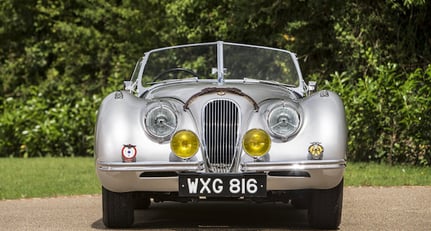1949 Jaguar XK 120
-
Baujahr1949
-
Chassisnummer670061
-
MotornummerW1114-8
-
Losnummer315
-
LenkungLenkung links
-
ZustandGebraucht
-
Zahl der Sitze2
-
Standort

-
AußenfarbeSonstige
-
Antrieb2wd
-
KraftstoffPetrol
Beschreibung
1949 Jaguar XK120 Alloy Roadster
Registration no. WXG 816
Chassis no. 670061
Engine no. W1114-8
'We claimed 120 mph (for the XK 120), a speed unheard of for a production car in those days' - William Heynes, Chief Engineer, Jaguar Cars.
Told by the post-war Attlee government to 'export or die', the British motor industry responded valiantly, none more so than Jaguar Cars, soon to become the UK's biggest US-dollar earner thanks in no small measure to the success of its XK120 sports car. Ironically, the XK120's creation had only come about because delays in the gestation of the MkVII saloon had forced Jaguar to find an alternative method of bringing its new XK six-cylinder engine to public attention. Conceived and constructed in but a few months, the XK120 debuted at the 1948 Earls Court Motor Show where the stunning looking roadster caused a sensation.
Conceived as a low-volume model, the XK120 proved considerably more popular than expected, the resulting demand for what was then the world's fastest production car taking Jaguar by surprise. It was immediately obvious that the ash-framed alloy coachwork hand built in the best vintage tradition - would have to go and the XK120 was re-engineered in steel after 240 cars had been completed.
Its stunning appearance notwithstanding, the XK120 was conventional enough beneath the skin, being built on a separate chassis - in essence a shortened and narrowed MkV frame - featuring independent front suspension by means of wishbones and torsion bars, a live rear axle, and drum brakes all round. The fact that the major mechanical components were already in existence meant that development centred on the body. The work of Jaguar boss William Lyons himself, and one of the most beautiful shapes ever to grace an automobile, the latter was conceived as a coachbuilt aluminium structure for the simple reason that Jaguar expected to sell no more than 200 XK120s in the first year!
The car's heart was, of course, the fabulous XK engine. Conceived in wartime and intended for Jaguar's post-war range-topping saloon, the 3.4-litre six embodied the best of modern design, boasting twin overhead camshafts running in an aluminium-alloy cylinder head, seven main bearings, and a maximum output of 160bhp. When installed in the lightweight XK120, the result was a car with a phenomenal power-to-weight ratio and blistering performance. The '120' referred to the car's top speed, and Jaguar lost no time in demonstrating that this was no idle boast. Any doubts about the claim's veracity were swiftly banished when in May 1949, on the Jabbeke to Aeltre autoroute in Belgium, a standard X120 achieved a top speed of 126.4mph with hood and side screens erected, and 132.6mph minus its weather protection and equipped with an under-tray!
The XK120 set new standards of comfort, roadholding and performance for British sports cars and, in keeping with the Jaguar tradition, there was nothing to touch it at the price. Coupé and drophead coupé versions followed, and for customers who found the standard car too slow, there was the Special Equipment package which boosted power from the stock 160 to 180bhp. With either engine and regardless of the type of bodywork, the XK120 was a genuine 120mph car capable of sustained high-speed cruising. From launch until the end of production in the autumn of 1954 the XK120's popularity never slackened, especially in overseas markets that took over 85 percent of total output. In the end a little over 12,000 XK120s were built, making every one of the 240 alloy-bodied roadsters something very special indeed.
The 61st alloy-bodied XK120 roadster built, '670061' is one of 184 delivered with left-hand drive. Believed owned originally by one Roger Thomas of Connecticut, the XK was later converted to right-hand drive and refinished in silver with blue leather interior, its current livery.
The immediately preceding owner, American collector Charles 'Chuck' Swimmer, acquired the Jaguar circa 2005 from his friend, Don Williams. Founder of the celebrated Blackhawk Collection, Mr Williams had purchased the car from its long-term owner in the UK. When acquired, it lacked rear-wheel spats and did not run well, so was immediately despatched to Jaguar Clubs of North America senior judge and restorer Jack Rabell, who added the spats and carried out extensive re-commissioning to ensure that the car would run properly.
One of his collection's earliest acquisitions, the XK120 was also Chuck Swimmer's most frequently used car. He drove it in the Colorado Grand on two occasions and also completed the California Mille, a combined total of some 3,000 miles of high-speed touring. Chuck Swimmer also showed the XK120 on occasions, and at the San Diego Concours in 2007 it was inspected by the JCNA's Jack Rabell and Tom Krefetz. Only some minor details were found to detract from this otherwise very correct and authentic car, and these shortcomings were subsequently put right in Jack Rabell's workshop.
Following Chuck Swimmer's death in December 2013, cars from his San Diego Collection were offered for sale at auction in the USA, which was where this XK120 was purchased by Chris Evans. It has since been registered in the UK and is offered with a V5C registration document and Jaguar Heritage Certificate. Importantly, '670061' retains its original tool kit and comes with a set of wheel discs and rear spats. Equally at home on the concours lawn, racetrack or Grand Tour, this early alloy-bodied XK120 roadster is without doubt one of the more significant Jaguars to come to the market in recent years.



















